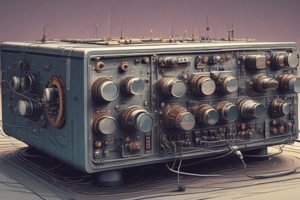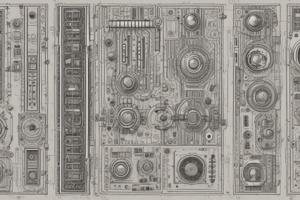Podcast
Questions and Answers
How does an analog output relate to an analog input?
How does an analog output relate to an analog input?
- Analog outputs are merely a duplicate of analog inputs.
- Analog outputs are the reverse of analog inputs. (correct)
- They are the same process with no variations.
- Analog outputs require different signal ranges than analog inputs.
What does the phrase 'four to twenty milliamps' refer to?
What does the phrase 'four to twenty milliamps' refer to?
- The voltage range of the sensor.
- The range of digital signals.
- The current range used for analog signals. (correct)
- The maximum output of the PLC.
What happens during the D to A conversion process?
What happens during the D to A conversion process?
- A digital value is converted into a physical analog signal. (correct)
- The output signal is filtered before reaching the actuator.
- The system records the analog signal in its temporary memory.
- An analog voltage is quantified into a digital format.
When sending a signal to the valve, what is the significance of using three quarters of the full range?
When sending a signal to the valve, what is the significance of using three quarters of the full range?
Flashcards are hidden until you start studying
Study Notes
Analog Inputs and Outputs
- Analog outputs mirror analog inputs in functionality, with inverse operations.
- Setting a valve to 75% involves writing a value of 75 to the memory address 0 to 4096.
- Output range for the valve operates between 4 to 20 milliamps.
- Achieving 75% on the valve translates to sending 15 milliamps (three-quarters of the 4-20 mA range) to the device.
Data Conversion Processes
- The Digital-to-Analog (D/A) process is essentially the reverse of the Analog-to-Digital (A/D) process.
- Analog inputs to a Programmable Logic Controller (PLC) sense signals between 4 to 20 milliamps and convert them to digital values.
- Conversely, the D/A process involves reading digital values from memory and sending them as analog signals to external devices or sensors.
Studying That Suits You
Use AI to generate personalized quizzes and flashcards to suit your learning preferences.




